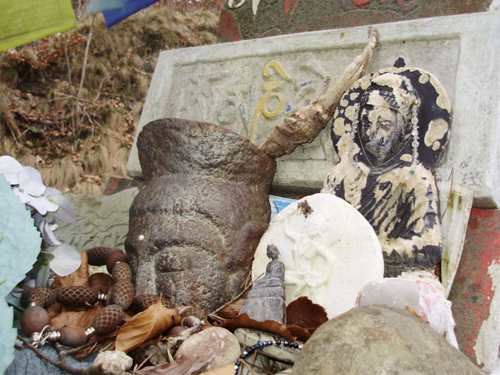Navigation auf uzh.ch
Navigation auf uzh.ch
Responsible for the doctoral project: Sarah Vandenreydt, lic.phil.
Funded by: URPP Asia and Europe
Project duration: January 2009 – December 2010
Doctoral comittee: Prof. Dr. Christoph Uehlinger, Religious Studies/URPP Asia and Europe; Prof. Dr. Raji C. Steineck, Institute of Asian and Oriental Studies, Japanese Studies/URPP Asia and Europe; PD Dr. Helmut Zander (Ruhruniversität Bochum)
Research field: Concepts and Taxonomies

Waldrand beim Tibet-Institut in Rikon
The project is concerned with the analysis of representations and classifications of “buddhism” as “philosophy” and/or “religion” in the writings of F. M.Müller, H. P.Blavatsky and A. P.Sinnett. Still current in contemporary discourse on Buddhism, the distinction gained prominence in 19th century England when new scientific discoveries and social change led to considerable religious and epistemological turmoil and challenged religious institutions and authority. In this context, conceptual frameworks including “religion”, “philosophy” and “science” and their respective place in the taxonomy of knowledge were questioned and hotly debated. Elites of various backgrounds construed their discourse upon dichotomic pairs such as “religion” vs. “philosophy”, or “religion” vs. “science”, while others in contrast suggested novel conjunctions of these terms. Both philologists and historians of religion, who defined a newly circumscribed entity called “buddhism” in roughly that period, and protagonists of the theosophic movement had their share in the more general taxonomic debate.
The then nascent concept of “buddhism” may thus be considered a diagnostic marker of the taxonomic debates involving both academic elites and religious leaders representing established institutions and nascent movements alike. Our study will concentrate on a discourse analysis of major programmatic texts authored between 1975 and 1900 by three prominent voices: Friedrich Max Müller (1823–1900), often considered as the founder of the Science of Religion, through his major Lecture Series on religion, mainly the Hibbert and Gifford Lectures; Helena Petrovna Blavatsky (1832–1891), founder of the theosophical society, through her book „Secret Doctrine“; and A. P. Sinnetts (1840-1921) and his „Esoteric Buddhism“.
The results of this analysis will allow us to shed light on an important phase in the history of the classification of Buddhism: how is the dichotomy “philosophy vs. religion” used in public presentations of “buddhism”? What was at stake for the British society with this taxonomic distinction? What kind of religious and social values were related to it? How did these descriptions and classifications shape the general perception of Buddhism at the time, and how do they influence representations of “buddhism” still in use in our own days?